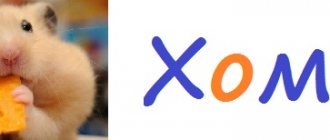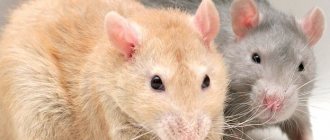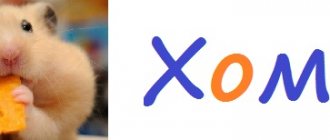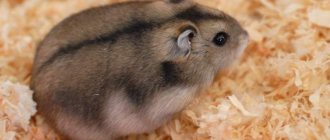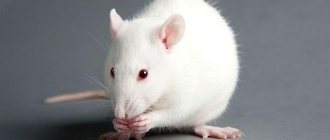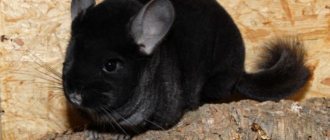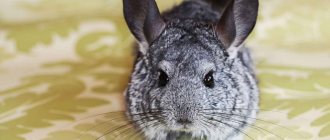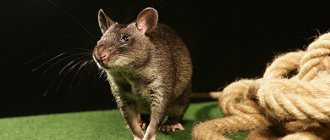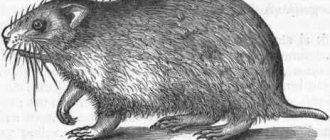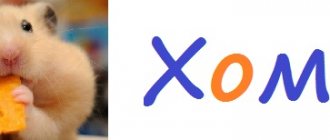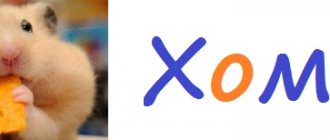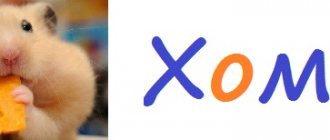Rodent comparison
Before you go to the pet store to buy a new pet, you need to learn a little about the characteristics of each rodent. A short comparison table will help make this task easier:
| Characteristics | Chinchilla | Guinea pig |
| Dimensions | More compact, the weight of an adult animal, depending on gender, is 500-800 g, body length - 23-38 cm. | Larger animals. The average body weight of a guinea pig ranges from 900-1400 g, and its length is approximately the same as that of chinchillas. |
| Appearance | They have dense fur and a relatively slender body, with a long fluffy tail. | They are distinguished by a stockier build and a flattened face, the tail is small and barely noticeable. |
| Lifestyle | They are nocturnal. They sleep most of the day. The period of activity occurs in the evening and at night. | They sleep at night and are active during the day. |
| Lifespan | 15-18 years old, with good care they can live up to 20 years. | The average life expectancy is 5-6 years, but they can live up to 9-10 years. |
| Nutrition | Plant food. | Plant food. |
| Reproduction | The organs of the reproductive system complete their formation at 5-6 months. Pregnancy lasts from 95 to 115 days. Young females give birth to 1-2 puppies, and older females give birth to 5-6. | Puberty occurs at 1-1.5 months. Pregnancy lasts 60-75 days, in a litter there are from 1 to 6 cubs. |
| Character | Solitary animals that do not need company. Willful, it takes a long time to tame. | They can live alone, but prefer to spend time in company. Friendly and flexible. They go to the hands, love the attention of the owner. |
It is worth noting that chinchillas and guinea pigs have one very important thing in common. The homeland of both species of rodents is South America, the Andes. Perhaps that is why there are sad repetitions in their history. Guinea pigs, like chinchillas, were used as a source of tasty meat and fur. First, the animals were captured by the Indians, then by European poachers.
Homemade "toy"
Rex
They are bred not only to obtain beautiful skins, but also as “couch” pets. They are friendly, easy-going and get along well with people and other animals. There are special decorative dwarf species that are easy to accustom to the litter box and other objects of “cat” civilization. You just need to take into account that cozy soft “toys” make good jumpers (up to a meter high) and rodents that, in addition to carrots, are not averse to testing electrical wires and cables.
Rex
They feel good in our harsh climate; they can be housed in cages right on the street, under a canopy. In summer, it protects fur animals from overheating (air temperatures above 25 degrees are poorly tolerated by them). Only newborn rabbits (which look very similar to squirrels) require more thorough, warm rooms. Rexes, unfortunately, do not produce large offspring (usually no more than 7), but they are valued quite highly on the market. Babies are put up for sale and purchased when they are 1 month old, and it is important that the animals do not have drooping ears or matted fur - signs of a defect in the breed.
The cage is made of durable material that cannot be chewed, the bottom is mesh with bedding on top. They carefully monitor cleanliness to prevent the spread of infections and parasites. Animals should always have clean water in their drinking bowls (heated in cold weather), and hay should not fall out of the feeder (royal rabbits do not eat from the floor).
Rabbits of this breed eat in small portions, but often: it is better to distribute food at strictly defined hours (for adults - 3 times, for babies and mother rabbits - 4 times a day), so that gastric juice is actively produced and the food is well absorbed. For healthy digestion, approximately 2/3 of the diet should consist of foods containing fiber - hay and green succulent food.
It is important to provide a varied diet. The menu is based on grain concentrates, especially from oats and corn with the addition of cake and bran. Oats can be given dry, and corn grain can be crushed and slightly soaked in water until soft. The female rabbit and her offspring must cook barley, oats and legumes after grinding; goat’s milk is also beneficial for the family.
Concentrates can replace special feed for rabbits; sometimes, in force majeure circumstances, an option intended for pigs or calves is allowed, but not for birds (due to the presence of shells and small stones in it).
A significant part of the “velvet hares” diet is given to green food (from spring to autumn), which can be prepared in the garden, as well as in the forest, field, and meadow. They will go into action:
- fodder cabbage, tops of fodder beet, turnip, rutabaga, Jerusalem artichoke, sugar beet and rhubarb;
- herbs clover, alfalfa, nettle, burdock and dandelion.
In winter, when there is no greenfinch, vegetables and root vegetables are actively fed: carrots, potatoes, beets, zucchini, pumpkin (good boiled), turnips, and apples. Rabbits also need hay, branches, and sometimes straw. Vitamin-rich twigs of juniper, spruce, pine, rowan, linden, birch and apple trees are prepared for future use.
Keep in mind that edible plant foods may accidentally contain harmful ingredients: tops of tomatoes and potatoes, branches of cherries, cherries, plums (contain hydrocyanic acid), poisonous branches of wild rosemary, buckthorn, apricot, elderberry and bird cherry. The prohibited list also includes henbane, buttercup, lily of the valley, spurge, night blindness, fern, and datura.
It can be difficult to balance such a variety of feeds on your own; pets may experience a lack of certain vitamins and microelements. Often rabbits begin to go bald and pluck each other's fur. To ensure that animals are provided with the full range of necessary nutrients, use a specially created premix -
"Health for rabbits." It contains a complex of vitamins - A, B1, B2, B3, B4, B5, B12, C, D3, E, biotin; list of important macro- and microelements. With the supplement, animals' appetite and vitality improve, and the incidence of illness decreases. The weight increases, the coat becomes dense, dense and durable.
Advantages and disadvantages of chinchillas
Chinchillas are very cute-looking rodents. Their maintenance does not cause much trouble. And with the right approach, you can establish a close psycho-emotional connection with your furry pet. At the same time, these cute animals have many advantages:
- Their fur is hypoallergenic , so people suffering from allergic reactions can easily get them.
- They do not have sweat glands . Accordingly, there is no unpleasant odor coming from the cage with the pet.
- Chinchillas rarely get sick , so under the right conditions they can easily live to a ripe old age.
- No need for company . A chinchilla can independently find ideas for spending time. In addition, the fluffy dog does not require the attention of the owner.
- No shedding . Despite the fluffy coat, the animals’ hair practically does not fall out. Therefore, the pet does not bother the owner with frequent cleaning of the apartment.
- Diverse breed composition . Breeders have bred more than 20 varieties of chinchillas. So, everyone can choose a pet to their liking.
- High level of intelligence . Chinchillas are smart, they respond to their names and can be taught simple tricks.
Cute animals are not without their shortcomings. Fortunately, there are not many of them. The main disadvantages of chinchillas include:
- Complex nature . The animal cannot be picked up without permission. The pet loves solitude and prefers not to be disturbed again. Otherwise, he may harbor a grudge.
- Nocturnal lifestyle . The pet will inevitably make noise at night and wake up everyone in the household.
- Sensitivity to environmental conditions . Chinchillas naturally live in cold mountain climates. Therefore, when keeping an animal, it is necessary to maintain a cool temperature at home - within +18-20ᵒС. Fluffies feel especially uncomfortable in the summer.
- Food sensitivity . A chinchilla can only be fed with specialized food and several additional natural foods (fruits, vegetables, nuts, cereals, berries, seeds). At the slightest deviation from the diet, the pet’s well-being deteriorates sharply.
At the same time, it is very difficult to obtain qualified medical care for a chinchilla. The fact is that these rodents are very specific, and only specialists with a narrow focus can handle their treatment. It is especially difficult to find a professional veterinarian in remote cities.
When organizing feeding a chinchilla, you should not change specialized formulations too often. If you suddenly switch to even super-premium food, your pet’s health may deteriorate.
“And under this guise he was hiding...”
A year ago, a work colleague encountered deception and for a long time had to “scrape out” money for a fur coat that was returned to the store. Despite the fact that the truth was on her side: the owner of the salon deliberately misled her, fortunately, the words “beaver” and “beaver” have the same root.
We must pay tribute: the fur coat was beautiful - light silver, fitted silhouette and comfortable length (just below the knee), with bell sleeves and a voluminous hood. It gently “flowed” over the figure, “enveloping” the owner of the fur coat with warmth and comfort. But this does not mean that it could be sold for fabulous money!
The “beaver” turned out to be not a waterfowl with the strongest and most durable fur, the beaver, but a Rex rabbit with a beaver-like skin. Plush, velvet, velor - that’s how you want to name these animals and stroke their soft, even fur, how attractive they are!
The history of these living soft toys began in France, at the beginning of the twentieth century, when a rabbit with an unusual fur texture was presented at one of the exhibitions. He was named "Rex", which translated from Latin means "king, king". The breed was obtained as a result of long-term selection of representatives of domestic (the Belgian giant breed, which is the size of an average dog) and wild rabbits.
A mutation in one of the genes in the body of rex rabbits causes the hair to grow not at an angle, but vertically: while the main and guard hairs remain the same length (about 2 cm). That is why the fur turns out smooth - without “transitions” from short undercoat to long hair. Rex can have more than a dozen different colors - white, black, lilac, chocolate, speckled, agouti (interesting shades - as if shaded, “camouflage”: they originate from predator hunters in nature).
Yellow-bellied marmot - why not a beaver?
Now breeders have developed several variants of rex, which are very similar in appearance to the fur of valuable fur-bearing animals. For example, castor rex: translated as “king of the beavers” (French castor from the Greek kastor - beaver). The rabbit looks very much like our Red Book beaver, deep chestnut color with a beautiful chocolate tint. For information, castor is also called dense pile cloth made from yarn with the addition of beaver or goat down.
The “King of Martens” is the Marder Rex breed - almost a copy of the durable, expensive fur of mammals from the mustelidae family. Skins from real martens and sables were previously called “soft gold”, which was used to pay for goods, considered the hardest currency.
This is not a chinchilla rex, but a real chinchilla.
Another premium type of Rex rabbit is the chinchilla. It practically does not differ in color from its high-mountain rodent “doubles”. Fur coats, capes, and blankets made from such fur look original, almost “luxury.”
Advantages and disadvantages of a guinea pig
Guinea pigs are also not without their advantages and disadvantages. The strengths of these cute rodents include:
- High contact . Guinea pigs are happy to make contact with their owner and other family members. They do not require long-term taming. They love to spend time with people.
- Optimal daily routine . Guinea pigs are quite active. But unlike chinchillas, they sleep well at night. And in general, they easily adapt to the rhythm of their owner’s life.
- Pleasant appearance . The fur of guinea pigs is not as dense as that of chinchillas, but still quite fluffy. In addition, among these rodents you can choose a pet with an interesting “hairstyle” - their fur is not only straight, but also wavy and curly.
- Do not require complex care . It is enough to periodically change the bedding in the cage (once every 4-5 days) and feed the animal regularly - for normal life, a guinea pig needs 1 tablespoon of food.
For the sake of fairness, it is worth saying a few words about the shortcomings of these cute animals:
- if they are not properly cared for, they give off a very specific unpleasant odor;
- during mating activity they may "chirp" and make other sounds at night;
- compared to chinchillas, they live much shorter lives;
- does not know the limits in food - if you do not control the appetite of a guinea pig, it can eat an unlimited amount of food, which will lead to dire consequences for health.
Another disadvantage of guinea pigs is early puberty and the desire to constantly reproduce. Therefore, the owner will have to send the pet for sterilization or constantly look for where to place the offspring.
Guinea pigs' claws grow quite quickly. Therefore, they will have to be constantly trimmed. You can do it at home using regular nail scissors.
Rabbit & chinchilla: choosing a pet
“Which should I get, a rabbit or a chinchilla?” This question is often asked by people who want to get a new pet. To help you make your choice, let’s now compare these charming fluffies according to the most basic parameters.
Smell and tray
The main factors of interest to a person planning to get a pet. Chinchilla doesn't smell. In the cage he chooses one corner for the toilet, washing which completely eliminates unpleasant odors from feces. When moving around the apartment, he can shit anywhere. There is a smell from the rabbit. The tray and cage will have to be washed regularly, sometimes 2 times a day. But the rabbit easily gets used to the tray, into which it runs while walking around the room.
Which is better to choose: chinchilla or guinea pig?
There is no clear answer to the question of who is better to choose: a chinchilla or a guinea pig. Each person must make an independent decision based on their own preferences. For example:
- People who work a lot and cannot devote time to their pet should choose a chinchilla. Those for whom contact with a four-legged friend is important and who are ready to pay attention to him should choose a guinea pig.
- For families with children, a guinea pig is also more suitable. Firstly, it will not make noise at night. Secondly, you can play with it and have fun.
- For allergy sufferers, it is better to buy a chinchilla. The fur of these cute fluffies does not cause absolutely any skin or respiratory reactions.
- If a potential owner feels that he cannot provide an optimal microclimate for a chinchilla, he should opt for a guinea pig, which is not so sensitive to environmental conditions.
The main thing that needs to be taken into account when choosing between a chinchilla and a guinea pig is that your future pet should have a heart. After all, furry rodents are not just animals. Over time, they will definitely become full-fledged members of the family, so it is better to choose them guided by your heart.
